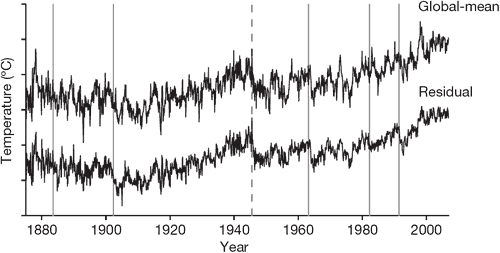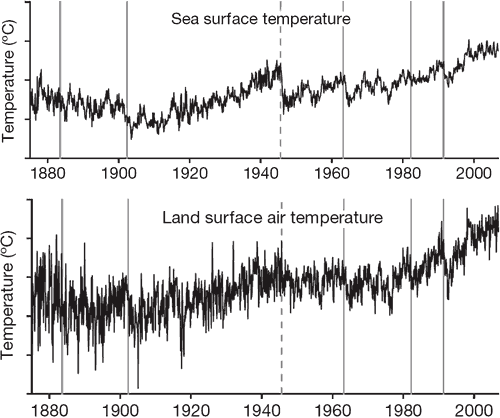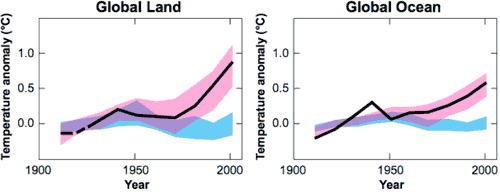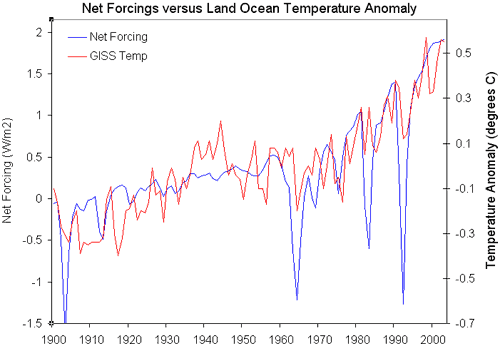A new twist on mid-century cooling
Posted on 2 June 2008 by John Cook
A persistent skeptic argument is the global cooling between the 1940's to the 1970's. 30 years of cooling during a period of increasing CO2 levels definitely raises a few questions. One piece of the puzzle has been provided by a new paper A large discontinuity in the mid-twentieth century in observed global-mean surface temperature (Thompson 2008).
They note a dramatic drop in global temperature in 1945. To determine whether this may be due to internal variability, they filter out the ENSO (El Nino Southern Oscillation) and COWL (Cold Oceans Warm Land) signals. COWL refers to northern, high latitude winds that carry heat from land to ocean (or vica versa). The filtering produces a cleaner signal with less noise, further accentuating the discontinuity in 1945.

Figure 1: Original unfiltered temperature (top - Global-mean) and filtered temperature with ENSO and COWL removed (bottom - Residual). Solid vertical lines denote volcano eruptions. Dashed vertical line denotes August 1945.
Over the last century, most of the more prominent drops in global temperature coincide with large, tropical volcanic eruptions (the solid lines in Figure 1). However, there are no such eruptions in 1945 (the dashed line). In fact, the drop in 1945 doesn't appear to be related to any known physical phenomenon. Another clue is the fact that the discontinuity is apparent in sea surface temperatures (SST) but not in land temperatures:

Figure 2: SST versus land temperature (filtered with ENSO and COWL signals removed).
What caused such a dramatic drop in SST in 1945? In the wartime years leading up to 1945, most sea temperatures measurements were taken by US ships, who measured the temperature of the intake water used for cooling the ship's engines. This method tends to yield higher temperatures due to the warm engine-room environment. However, in August 1945, British ships resumed taking SST measurements. British crews collected water in uninsulated buckets. The bucket method has a cooling bias.
What is the significance? The full implications will be apparent when HadCRUT release revised data. A review article by Chris Forest in the same Nature publication suggests that ocean data in the early 1940's show an anomalous 3-4 year interval dominated by US data - which are upwardly biased by engine room intake measurements. When comparing climate hindcasts to observed land and ocean data (Figure 3), the early 1940's is the only period where observed data lie above model predictions. Land data show no such anomaly.

Figure 3: Comparison of observed land and ocean temperatures (solid black line) with climate results using only natural forcings (blue bar) and natural + anthropogenic forcings (red bar). Graph comes from Figure SPM-4 of the IPCC 4AR Summary for Policy Makers.
Forest predicts temperatures between 1942 to 1945 will shift downwards. This would make 1940's temperature data more consistent with climate models and remove the discontinuous cooling in 1945. How much the temperature changes in the years before and after 1945, we'll have to wait and see when HadCRUT release the revised data.
Also, if I may rehash my own work, this early 1940's inconsistency is also seen when comparing radiative forcing to global temperature (which Quietman spotted pretty quickly):

Figure 4: Net forcing (Blue - NASA GISS) versus global land ocean temperature anomaly (Red - GISS Temp).
Finally, Thompson 2008 ends with an intriguing statement:
"compensation for a different potential source of bias in SST data in the past decade— the transition from ship- to buoy-derived SSTs—might increase the century-long trends by raising recent SSTs as much as 0.1 C, as buoy-derived SSTs are biased cool relative to ship measurements"
As if the mid-century cooling anomaly wasn't enough, they have to drop that little bombshell at the end! Will be interesting to see the revised HadCRUT data - both for the 1940's and apparently the past decade.































 Arguments
Arguments























 0
0  0
0






Comments